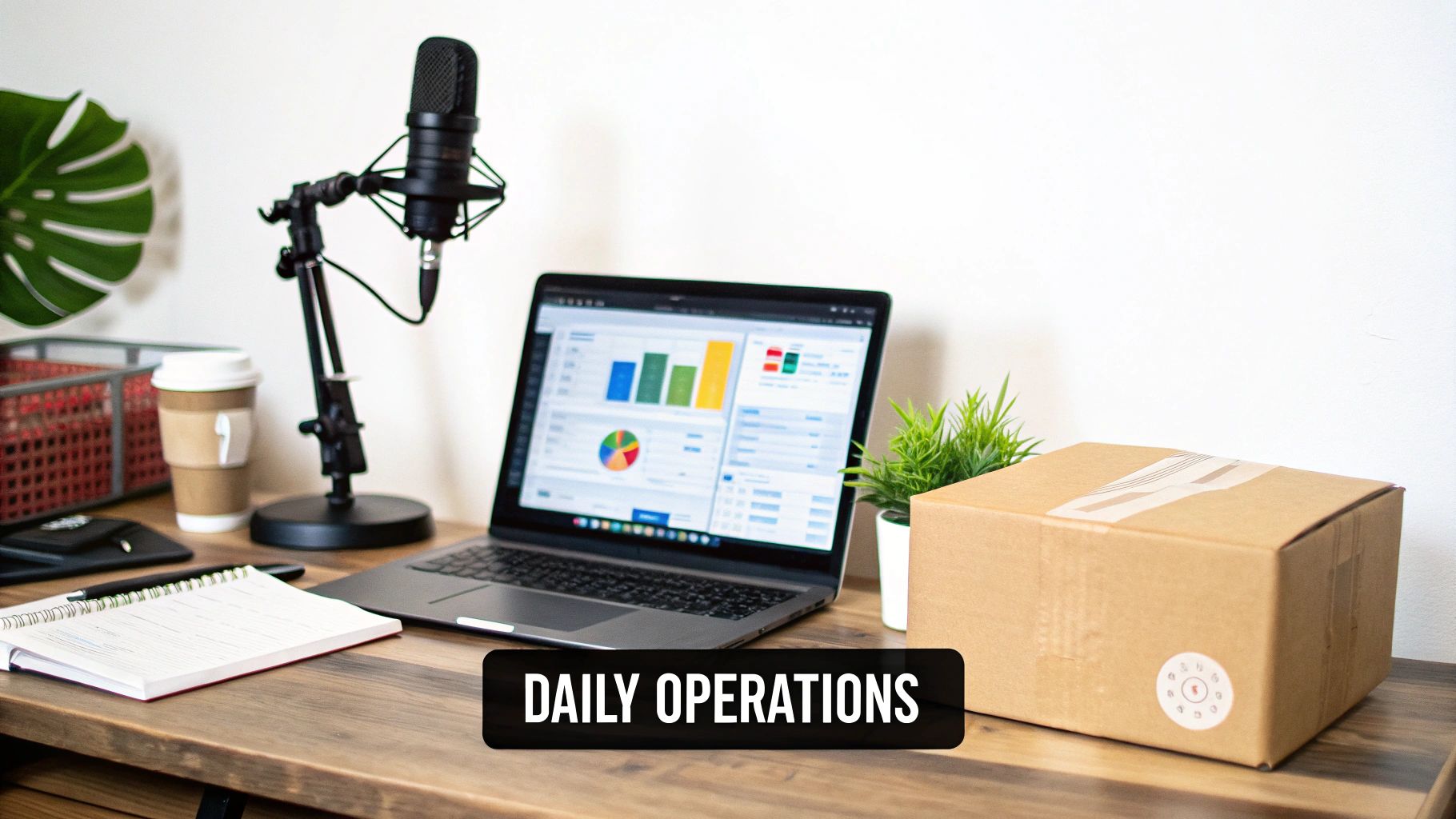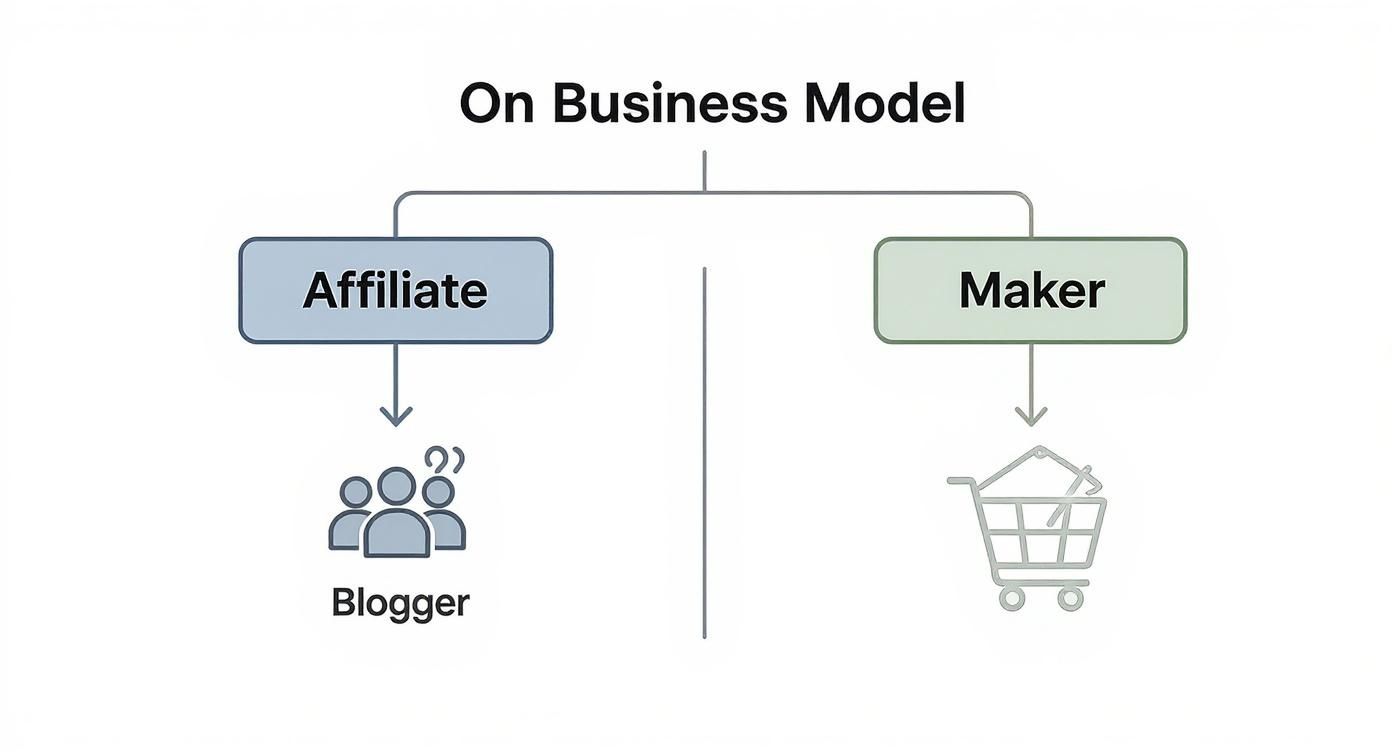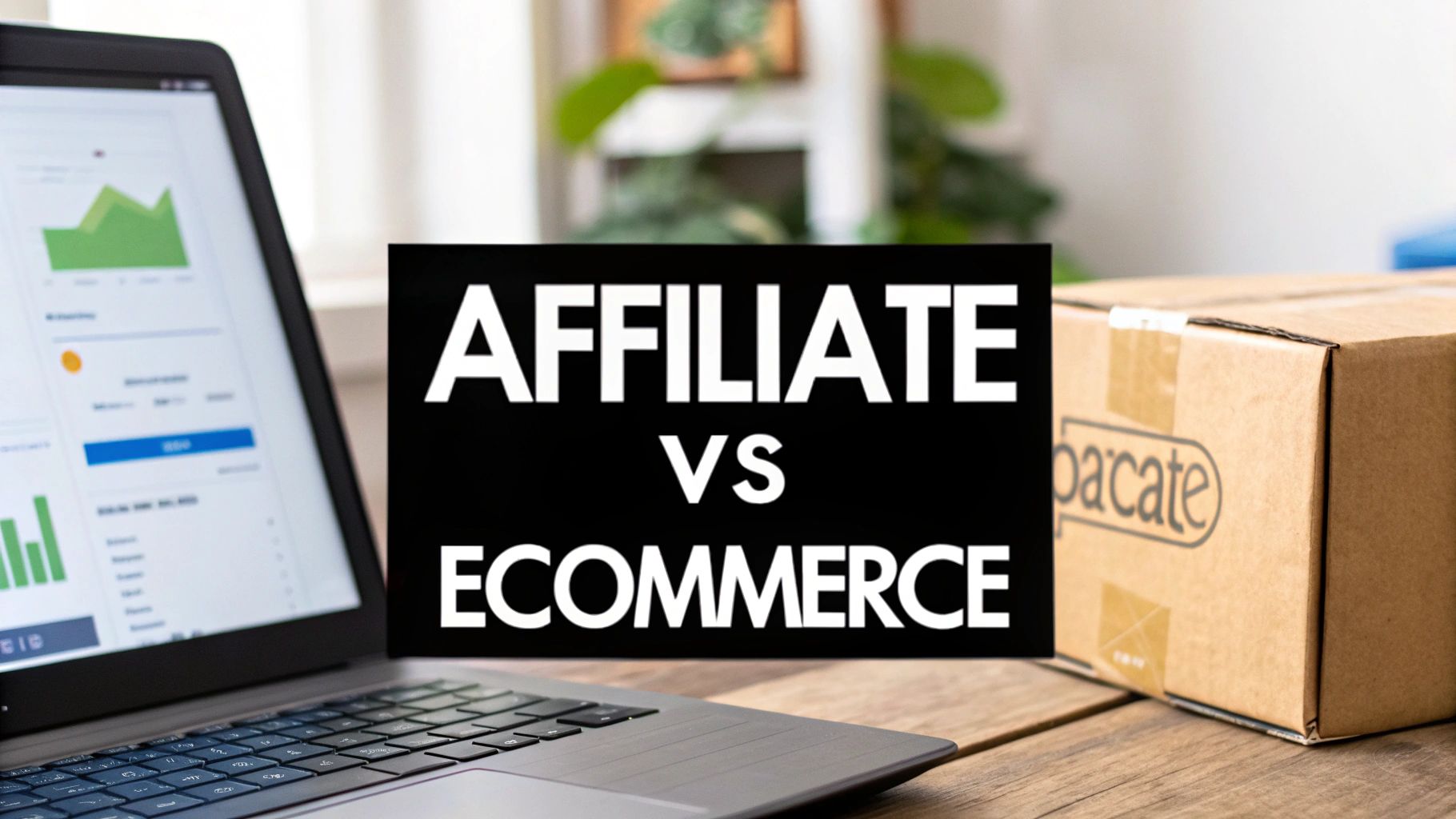When you're starting an online business, one of the first big decisions is how you're going to sell. Two of the most popular paths are affiliate marketing and ecommerce, and your choice here really shapes everything that comes after. At its core, the difference is straightforward: with affiliate marketing, you earn a commission for promoting someone else's products, whereas with ecommerce, you build a brand to sell your own.
The right path for you boils down to a classic trade-off: do you prefer lower risk and more flexibility, or are you after complete control and the potential for much higher profits?
Affiliate Marketing vs Ecommerce a Quick Comparison
To figure out which model fits you best, you need to get a handle on the key differences in how they operate, the costs involved, and the potential rewards. One route lets you dip your toes into online business with minimal upfront investment, while the other is about building a tangible, independent brand from the ground up. Before we dive in, it helps to be clear on the definition of Affiliate Marketing.

Core Business Model Differences
At its heart, affiliate marketing is all about performance. You’re essentially a freelance marketer who gets paid when you generate a sale for another company. Your main job is to create great content and build an audience that trusts your recommendations—without ever touching a product or worrying about shipping.
Ecommerce, on the other hand, puts you in complete control of the entire retail operation. You're the one sourcing or creating products, managing stock, handling payments, figuring out logistics, and dealing with customer service. It’s a lot more hands-on, but you’re building an asset that is 100% yours.
Don't underestimate the power of the affiliate model, though. It's a massive driver of the digital economy, accounting for roughly 16% of all ecommerce sales. The industry is booming, with U.S. spending alone hitting $13.62 billion and showing no signs of slowing down.
To make the comparison crystal clear, here’s a breakdown of how the two models stack up against each other.
Core Differences Between Affiliate Marketing and Ecommerce
This table gives a side-by-side look at the most important factors to consider when choosing your path.
| Factor | Affiliate Marketing | Ecommerce |
|---|---|---|
| Startup Costs | Very low (website/content tools) | Moderate to high (inventory, platform) |
| Inventory | None required | Required and must be managed |
| Primary Risk | Wasted time and marketing spend | Financial loss from unsold inventory |
| Profit Margin | Lower (commission-based, 5-30%) | Higher (full control over pricing) |
| Brand Control | Limited to promotional content | Full control over brand and products |
| Customer Service | Not responsible | Fully responsible for support |
As you can see, the decision really hinges on your appetite for risk, your starting capital, and whether you're more passionate about marketing and content creation or about building a product-based brand from the ground up.
Understanding the Day-to-Day Operations

When you're weighing affiliate marketing against ecommerce, it’s easy to get lost in high-level strategy. But what you really need to consider is what your day-to-day work will actually look like. The operational reality of each path couldn't be more different, demanding entirely separate skills and mindsets.
Think of it this way: one role is all about content and influence, while the other is about running a complete retail operation from the ground up.
The Affiliate Marketer's Daily Grind
An affiliate marketer’s day is built around creating and engaging. Their entire focus is on generating targeted traffic by publishing genuinely useful content, which is a world away from managing a storefront.
At its core, this job is about producing content that seamlessly weaves in product recommendations. It’s a creative and analytical role that prioritizes influence over logistics.
A typical day might look something like this:
- Keyword Research: Digging into what your audience is searching for and identifying topics that resonate.
- Content Creation: Writing blog posts, shooting videos, or crafting social media content that solves a problem or answers a question.
- SEO Optimization: Tweaking content to climb the search engine rankings and pull in more organic visitors.
- Performance Analysis: Logging into affiliate dashboards to see what’s converting, what’s not, and adjusting the game plan.
An affiliate marketer's true job is to build trust. Every piece of content is a chance to strengthen the bond with their audience, which makes their recommendations more powerful and their income more reliable.
Ultimately, their success hinges on their ability to inform and persuade. This hands-off approach to products frees them up to concentrate entirely on marketing—a major plus for anyone just starting out. You can learn more about this low-risk model in our guide to affiliate marketing for startups.
The Ecommerce Owner's Operational Loop
On the flip side, an ecommerce owner is a business operator in every sense of the word. Their day is a constant juggle of marketing, logistics, and customer service, requiring a hands-on approach at every single stage of the sales cycle.
Their responsibilities go far beyond just getting the sale. They own the entire customer experience, from the first ad they see to the package arriving at their door and any follow-up required. This demands a much, much broader skill set.
An ecommerce owner is constantly managing a complex chain of activities:
- Inventory Management: Watching stock levels like a hawk, reordering products, and trying to avoid the dreaded stockout or the costly overstock.
- Order Fulfillment: The physical work of picking, packing, and shipping orders out the door correctly and on time.
- Customer Service: Answering emails, handling returns, and managing reviews—both good and bad.
- Supplier Relations: Keeping in touch with manufacturers or wholesalers to talk about product quality, pricing, and lead times.
And unlike affiliate marketing, a critical part of the job is managing risk with robust e-commerce fraud prevention systems.
The number of moving parts is immense, which means an ecommerce owner has to be a master multitasker. While you get full control over your brand and profit margins, the operational burden is heavy. Your decision really comes down to this: would you rather be a focused marketer or a dynamic, do-it-all retail owner?
Analyzing Startup Costs and Financial Risks

When you're weighing affiliate marketing against ecommerce, money is almost always the deciding factor. The startup costs and ongoing financial risks for each model are worlds apart, and they cater to completely different budgets and comfort levels with risk. Getting a clear picture of this financial landscape is the first step to choosing the right path.
Think of it this way: one model lets you get started with barely any cash, while the other demands a serious financial commitment before you make a single sale. This isn't just about startup costs; it's about the kind of financial pressure you'll be under long-term.
The Low-Cost Entry of Affiliate Marketing
Affiliate marketing has a reputation for its incredibly low barrier to entry. That's what makes it so appealing for people who have more time than money to invest. The reason startup costs are so minimal is simple: you're a publisher, not a retailer. You don't have to worry about buying products, managing a warehouse, or dealing with shipping.
Your initial expenses really just boil down to the digital tools you need to build and reach an audience.
- Web Hosting and Domain: You'll want a professional-looking website, which you can get up and running for less than $100 a year.
- Content Creation Tools: This could be anything from basic graphic design software to a decent microphone or keyword research tools.
- Marketing Spend: Some affiliates use paid ads, but many start out with purely organic methods like SEO to avoid costs.
Because there’s no physical product to manage, the financial risk is practically zero. Your biggest investment is your time—the hours you pour into creating content and building a community. If a product you’re promoting bombs, you haven’t lost a dime on unsold inventory. You’ve just learned what your audience doesn't want, and you can switch up your strategy without any financial hit.
The Capital-Intensive Nature of Ecommerce
On the flip side, launching an ecommerce business requires a significant upfront investment. You're essentially building a retail operation from the ground up, and that means paying for the inventory and infrastructure before you can open your digital doors. For many aspiring entrepreneurs, this initial cash outlay is a major hurdle.
These aren't hypothetical costs; they're real, tangible expenses you have to cover before your store can even go live.
- Inventory Purchase: This is usually the biggest line item. Buying your initial stock from a supplier can easily set you back thousands of dollars.
- Ecommerce Platform Fees: Services like Shopify or BigCommerce charge monthly subscription fees, not to mention transaction fees that eat into your margins.
- Branding and Packaging: You'll need a logo designed, custom boxes sourced, and shipping supplies purchased.
- Payment Processing: Setting up the system to take credit cards comes with its own set of fees on every single sale.
The core financial risk in ecommerce is tangible and immediate: unsold inventory. Every product sitting in your storeroom represents tied-up capital that you can't recover until it's sold, directly impacting your cash flow and profitability.
With ecommerce, the financial risk is much higher. If your products don't sell, you're stuck with that sunk cost, forcing you to either heavily discount them or write them off as a loss. On top of that, you have ongoing operational costs like storage and platform fees that you have to pay every month, whether you're making sales or not. This financial pressure is a constant reality for ecommerce owners. To manage your budget effectively, it's crucial to understand how to calculate customer acquisition cost.
The return on investment (ROI) for affiliate marketing can also be a game-changer for those with smaller budgets. Businesses, for example, report earning an average of $6.50 for every $1 spent on affiliate marketing. This efficiency, combined with the explosive growth of social commerce—projected to hit $149 billion in the U.S. by 2028—shows why so many see it as a financially smart way to break into online sales.
Comparing Scalability and Long-Term Growth
Thinking about starting a business is one thing, but picturing where it could be in five or ten years is another. When you're weighing affiliate marketing against ecommerce, you're really choosing between two very different paths to long-term growth. How big can this thing actually get?
One model lets you grow by expanding your reach with surprisingly little overhead. The other scales through serious investment in operations and infrastructure. Let's break down what that actually looks like day-to-day so you can match your business model to your long-term ambitions.
How an Affiliate Marketing Business Scales
The growth of an affiliate business is all about your ability to build and engage an audience. Since you’re not wrestling with inventory or shipping, all your energy goes into creating content, driving traffic, and getting better at converting visitors into buyers. This is where you can see some impressive growth without a ton of cash.
Your revenue scales almost seamlessly with your audience. A blog post that earns $100 a month from 1,000 readers could, in theory, bring in $1,000 a month if you can attract 10,000 readers—all without your operational costs really budging.
To scale up, successful affiliates focus on three main areas:
- Growing the Audience: This means getting really good at SEO, finding your groove on social media, or building a powerful email list to keep new people coming in the door.
- Expanding into New Niches: Once you've mastered one area, you can take those same content and marketing skills and apply them to related product categories to open up new revenue streams.
- Mastering Conversion Rate Optimization (CRO): This is the art and science of tweaking your content, calls-to-action, and product reviews to get more of your existing traffic to click and buy.
But there's a catch. Your growth eventually hits a ceiling. Your income is always tied to the commission rates set by the brands you work with. Even with a huge audience, you're still only earning a piece of the pie, usually somewhere between 5% and 30% of the sale.
How an Ecommerce Enterprise Scales
Scaling an ecommerce business is a whole different ballgame. It’s about operational muscle and building out your infrastructure. While affiliate marketing growth happens online, ecommerce growth requires real-world investment in products, logistics, and people. It’s a path that demands more capital, but the potential rewards are unlimited.
As an ecommerce store takes off, the founder has to shift from being just an entrepreneur to a full-blown operator. You're no longer just getting more traffic; you're building a well-oiled machine that can handle more orders without falling apart.
The key levers you pull to scale an ecommerce business are:
- Expanding Your Product Catalog: This could mean adding new products or creating variations of existing ones to increase your average order value and appeal to a wider range of customers.
- Entering New Markets: You might start shipping internationally or create marketing campaigns to target entirely new customer demographics.
- Optimizing Your Supply Chain: This is the behind-the-scenes work of finding better suppliers, negotiating better prices, or bringing on a third-party logistics (3PL) partner to take over warehousing and fulfillment.
Affiliate marketing scales through influence, while ecommerce scales through infrastructure. One builds a media asset, the other builds a brand asset.
This is a critical distinction for long-term value. Scaling an ecommerce business is tough and expensive, but what you’re left with is a sellable brand. A business with a loyal customer base, a dialed-in supply chain, and steady revenue is a tangible asset that can be sold for a hefty sum.
An affiliate site can be sold too, of course, but its value is often pegged to traffic numbers and the hope that its partner programs don't change their terms. The choice between affiliate marketing vs. ecommerce often comes down to this: do you want to build a low-maintenance income stream, or do you want to build a valuable, sellable brand?
Choosing Your Model with Real-World Scenarios
Theory is great, but let's get practical. The affiliate marketing vs. ecommerce debate often clears up the moment you look at real-world situations. The best choice usually clicks into place when you see how each model aligns with a specific goal, skillset, or audience.
Instead of just listing pros and cons, let's walk through a few tangible scenarios. Seeing how these models play out for real people makes it much easier to picture where your own ambitions fit in.
When Affiliate Marketing Is the Clear Winner
Affiliate marketing really hits its stride when your biggest asset is your audience, not a physical product. If you're a natural at creating compelling content, building a community, and earning people's trust, this is your playground. The logistics of running an ecommerce business would just be a distraction from what you do best.
Think about these specific examples where affiliate marketing is a perfect match:
The Niche Blogger: Picture a finance expert with a popular blog dedicated to early retirement. Her readers hang on her every word about investing platforms, high-yield savings accounts, and budgeting apps. Creating her own financial product would be a monumental task. Instead, she can weave affiliate links to the very tools she already uses and trusts right into her articles. Her income is tied to her credibility, not her ability to manage inventory.
The YouTube Tech Reviewer: A creator who spends his days unboxing and testing the latest gadgets has built a channel on honest, deep-dive analysis. His value is in helping viewers cut through the marketing noise. By joining affiliate programs from retailers like Amazon or B&H Photo, he earns a small commission when a viewer clicks his link and buys. This lets him stay focused on what his audience wants: great video reviews.
The Social Media Influencer: A travel influencer with a huge Instagram following shares breathtaking photos and insider guides. Her DMs are flooded with questions about her luggage, her favorite booking sites, and what travel insurance she uses. Affiliate marketing lets her seamlessly embed those recommendations into her content, creating a stream of passive income without the headache of designing and shipping her own line of travel gear.
For content creators, affiliate marketing isn't just a business model—it's a natural extension of their work. It allows them to monetize their influence without compromising the trust they've built with their audience, which is their most valuable asset.
When Ecommerce Is the Right Path
Ecommerce is the only way to go when you have a unique product, a strong brand vision, and a deep desire to own the entire customer experience. This path is for the makers, the innovators, and the brand-builders who want total control and are ready to handle the operational work that comes with it.
Here are a few situations where building an ecommerce store is the obvious move:
The Artisan or Crafter: A jewelry maker designs and creates one-of-a-kind pieces. Her brand is built on her unique artistic vision and craftsmanship—things you can't find anywhere else. An ecommerce store gives her a direct line to customers, letting her control the pricing, tell her story, and build a loyal following of people who value her specific work.
The Inventor with a Unique Product: An entrepreneur develops a new kind of ergonomic office chair that solves a real problem in a novel way. To control the brand story, ensure top-notch quality, and capture the full profit margin, launching an ecommerce store is a must. It gives him a platform to educate customers on the chair's unique benefits and build a lasting brand around his invention.
The Creator Launching a Merchandise Line: A popular podcaster with a dedicated audience wants to give her listeners a way to show their support and feel more connected. She decides to launch a line of merchandise with inside jokes and logos from the show. Ecommerce is really the only model that works here. It lets her control the designs, quality, and shipping, making sure the products truly represent the brand her audience loves. Many successful stores also add a powerful word-of-mouth channel by creating a referral program for ecommerce, which turns happy customers into brand advocates.
Making Your Final Decision
Deciding between affiliate marketing and ecommerce is more than just a business move—it’s a deeply personal choice. The right answer hinges on your unique ambitions, how much risk you're comfortable with, and the resources you have at your disposal today. This isn't just about how you'll make money; it's about what your daily grind as an entrepreneur will actually look like.
To make a smart call, you have to be brutally honest about your starting point. Do you have more time than money, or more capital than time? Are you fired up by the idea of creating content and building a community, or are you driven to build and sell a physical product that's 100% yours?
Aligning the Model with Your Vision
The fundamental trade-off is pretty straightforward. Affiliate marketing is your low-risk, flexible on-ramp to the world of online business. You can get started with next to no capital, putting all your energy into creating great content and connecting with an audience, free from the headaches of inventory or customer service. It’s a perfect fit for creators, niche experts, and anyone looking to monetize their influence.
Ecommerce, on the other hand, is for the brand-builders at heart. It requires a bigger upfront investment and a very hands-on approach to every part of the operation, from managing stock levels to handling customer support emails. The payoff for all that hard work? Complete control, much higher profit potential, and the satisfaction of building a tangible, valuable brand asset.
The choice between affiliate marketing vs ecommerce really boils down to this: Do you want to build a media asset that earns through influence, or a brand asset that creates value through ownership?
This decision tree infographic can help you visualize the two paths based on where you want to focus your energy.

As the visual lays out, if your superpower is creating content and growing an audience, the affiliate route is a no-brainer. But if your passion lies in crafting and selling your own unique products, ecommerce is calling your name.
A Practical Framework for Your Choice
To tie this all together, run through these final questions before you commit to a path:
- Financial Risk: Can you realistically invest in product inventory, or do you need a business model with almost zero financial downside? If capital is tight, affiliate marketing is the safer bet.
- Time Commitment: Do you have the hours in the day to manage supplier relationships, deal with shipping logistics, and answer customer service tickets? If not, the content-first schedule of an affiliate marketer might be a more sustainable fit.
- Control vs. Flexibility: Is having total control over your brand, products, and pricing an absolute must-have? If yes, ecommerce is your only real option. If you’d rather have the freedom to promote a variety of products without being tied to operations, affiliate marketing delivers that flexibility.
In the end, there's no single "better" model in the affiliate marketing vs ecommerce debate—only the one that’s better for you. When you align your choice with your personal strengths, financial reality, and long-term vision, you can start your journey with the confidence and clarity you need to succeed.
Frequently Asked Questions
When you're trying to decide between affiliate marketing and ecommerce, a few questions always pop up. Getting clear answers is the key to figuring out which path—or even a blend of both—is the right fit for your goals and resources.
Can You Combine Affiliate Marketing with an Ecommerce Store?
Absolutely. In fact, running them together is one of the smartest moves you can make. Many top-tier ecommerce brands use affiliate marketing as a way to create new revenue streams and build deeper trust with their audience.
Think about it this way: say you run an online store that sells premium coffee gear. You can write blog posts comparing different espresso machines. While you sell your own branded accessories on the site, you can drop affiliate links for the high-end machines you don't stock yourself. Your site suddenly becomes an invaluable resource for coffee lovers, and you earn money even from visitors who aren't buying your products today.
This hybrid approach gives you several advantages:
- Monetize All Your Traffic: You're no longer limited to selling your own inventory. You can earn commissions from visitors who are just doing research.
- Build Real Authority: When you review a wide range of products, not just your own, you position yourself as a go-to expert in your niche.
- Fund Your Content: The affiliate income you generate can help pay for the high-quality blog posts, videos, and guides that attract new customers to your store in the first place.
Which Model Is Better for a Complete Beginner?
If you're starting from square one with little cash and no product of your own, affiliate marketing is almost always the easier entry point. The startup hurdles are just so much lower. You don't have to worry about creating a product, managing inventory, or dealing with customer service.
As a beginner, you get to pour all your energy into mastering one crucial skill: creating great content that pulls in an audience.
Affiliate marketing is like an apprenticeship in online business. It lets you learn the ropes of SEO, content strategy, and audience-building without the heavy financial risk of buying inventory upfront. You literally get to earn while you learn.
Ecommerce, on the other hand, throws you into the deep end. You have to juggle product sourcing, branding, web design, shipping, and customer support all at once. It's incredibly rewarding when it works, but it can be a lot for someone just starting their journey.
How Long Does It Take to See Profits?
This is the big question, and the answer for both models is "it depends." Neither is a magic button for instant cash; both demand real, consistent work.
With affiliate marketing, the runway is usually longer. It can realistically take 6 to 12 months of building an audience and getting your content to rank in search engines before you see consistent commissions roll in. That initial period is all about laying a foundation of trust and traffic.
An ecommerce business, in theory, can turn a profit much faster. If you have a great product and a smart paid ad strategy, you could see sales within the first few days or weeks. But here's the catch: those early profits are often razor-thin once you subtract ad costs and other expenses. The financial risk is also much higher from the get-go. The core difference is that ecommerce profits are often directly tied to your marketing budget, whereas affiliate income grows more slowly and organically alongside your audience.
Ready to add a powerful, scalable affiliate program to your SaaS? With Refgrow, you can launch a fully native and customizable affiliate dashboard inside your app in minutes. Join over 1,600 businesses and start building your growth engine today. Learn more at Refgrow.

